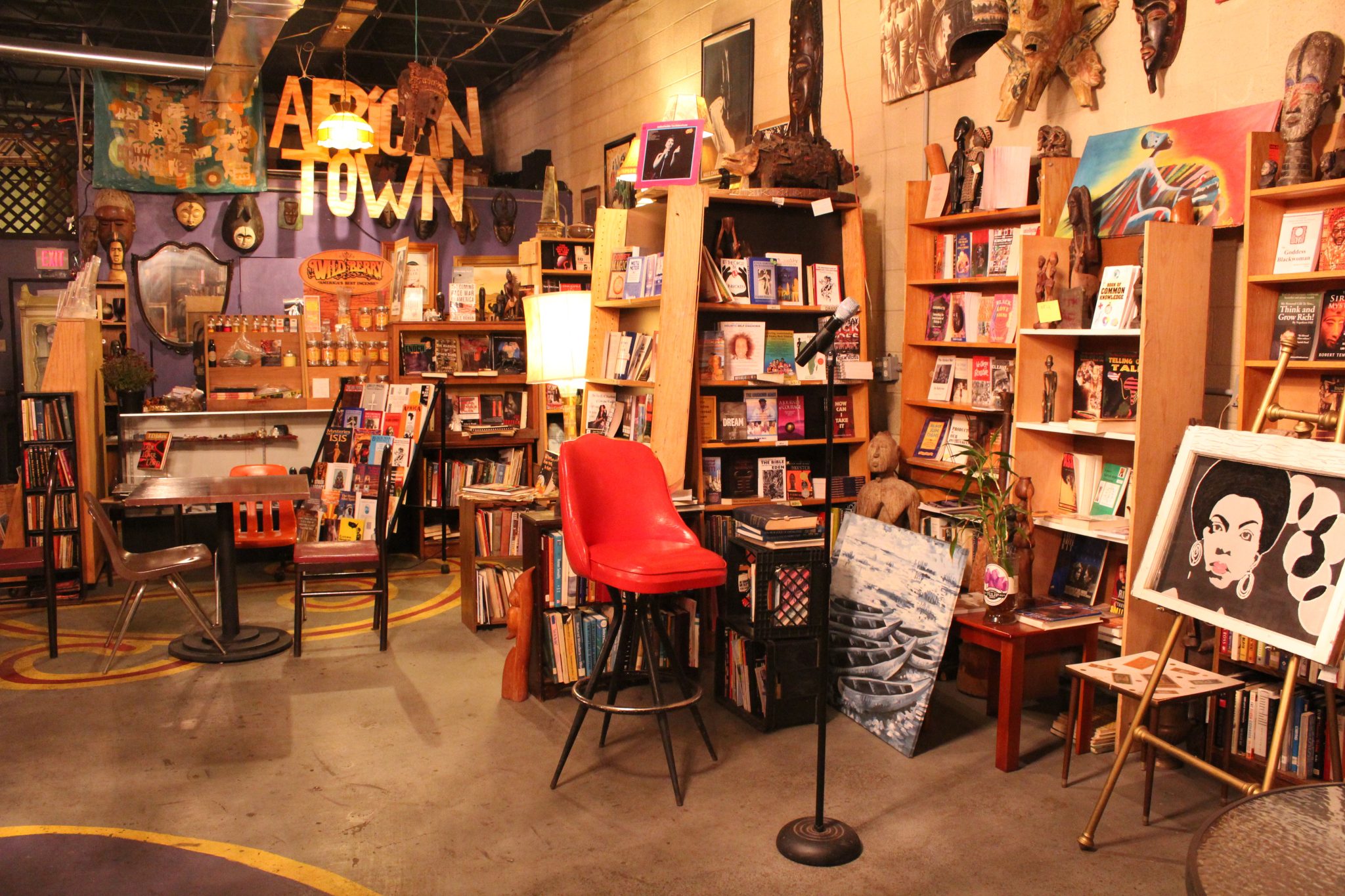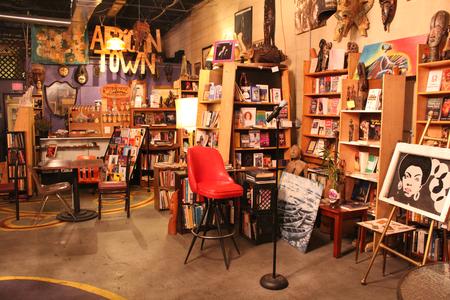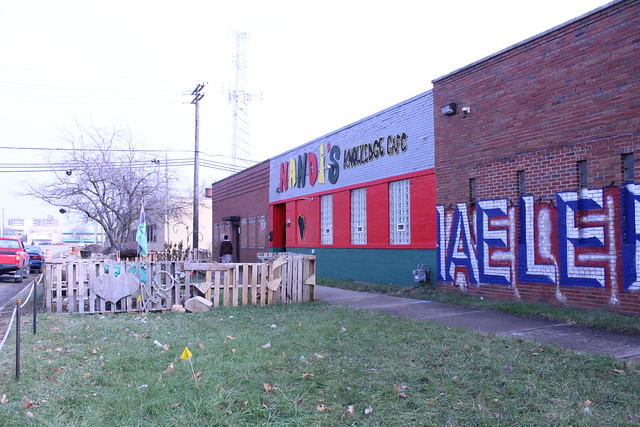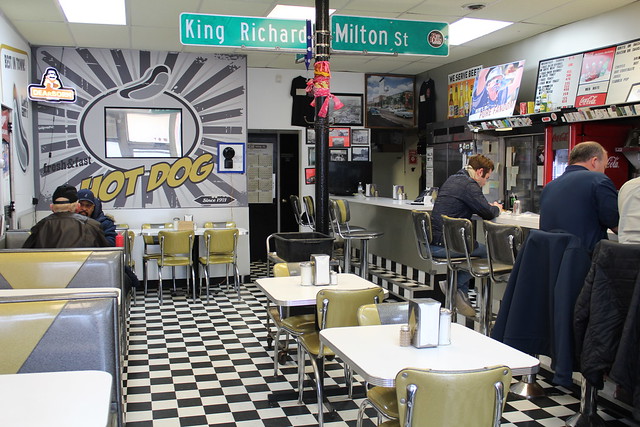Two Oases in Highland Park’s Restaurant Desert
Nandi’s Knowledge Cafe and Red Hots Coney Island are standout food spots in the city.

As highlighted in a WDET story yesterday, Highland Park, Mich. doesn’t have a bar (though a couple are now in the works).
Highland Park is also low on full-service restaurants where patrons are waited on at tables.
Some establishments like Parkside Coney, Three Sister’s Café, and China Star offer robust menus and higher quality food, but you can only order at their counters. The bulk of food spots in Highland Park are fast food.
There are, however, two establishments in the city that stand out for their food, service and interiors: Red Hots, a Coney Island that feels like its of another era, and Nandi’s Knowledge Café, an African-centered book store, art gallery and cafe.
Back Home: Nandi’s
“When they open that second door, they’re just amazed, like they done walked into… when Black Panther came out I started saying, ‘Welcome to Wakanda.’ And so, they just walked into another world. Actually you’re walking into an African world.”
This is Nandi, the woman behind Nandi’s Knowledge Cafe, describing what it’s like to walk into the latest location on Oakman Boulevard in Highland Park.
WDET’s Laura Herberg recently had the chance to sit down with Nandi in her cafe. They talked for nearly an hour with her grandson playing nearby. Below you can read highlights from that conversation. Or you can listen to 11 minutes of highlights by clicking on the link below.
Listen HERE
Laura Herberg: Let’s talk about the food here. For someone who’s never had the pleasure of coming in, what can they expect? And who makes all the food?
Nandi: Well, I make all the food and I have a brother named Kente who I’ve shared my recipes with and he follows those recipes very well. My ingredients are handmade like my black bean burgers, I hand make my salmon burgers, my turkey burgers. I don’t buy anything frozen. I’m very selective on my chicken. I buy the Amish chicken. I cook food that I’ll eat. I actually cook what I like. That’s it, that’s what I serve, what I like. I have a small menu where as if I didn’t have any help I can service all the people myself.
LH: Let’s talk about the books a little bit more. Would you describe them generally as Afrocentric? Or, what’s the phrase you would use?
N: My focus on my new books are African-centered books, but it’s all kind of books here.
LH: What’s one you would recommend to someone who, their African-centered education, is little to none. What’s a good intro book?
N: I start them where I started: Nile Valley Contributions to Civilization, written by Anthony Browder. It’s a book that covers a big, broad perspective on history. It directs you to what particular history you want to focus on. People have so many different subjects they want to focus on. What interests them, you’ll find it.
Like, if you just want to stick with metaphysics, or if you just want to stick with the study of Egypt, or stick with the study of holistic health, or goddesses – Nefertiti, the origins of the universe, astrology… we have astrology class here. And just all those books on all those subjects that really gear back to Africa.
LH: Let’s talk a little bit more about the art. How would you describe your collection here?
N: I would describe my collection as old. I have a knack for buying ancient art. Like this piece right here, it’s probably about 90 years old. It’s a Dogon piece.
LH: Would you describe that piece?
N: It’s a pot where you bring offerings to the gods or the deities. It opens up. And it’s one of my most expensive pieces here. I think it should be worth more but I’m just a small little store and I make room for people. If they buy it and they want to resell it they can. But I think if this piece was anywhere else it would be anywhere from $15,000-$30,000.
LH: You’re selling it for $6,000.
N: Even with the damages, but we’re talking about, you know, 80 years old or so. And it had to move quite a bit to get to this point.
LH: Where did you get it from?
N: I bought this from a collector who passed.
LH: Does all your art have a tie to Africa?
N: Yep, as you can see, yes it does.
LH: Tell me about your staff. How many people work here?
N: My staff is pretty voluntary. They’re a volunteer, type of staff. Either way I’m going to look out for them. You know? But they don’t bother me about much. They can eat, we help each other, and they’re the greatest volunteers I’ve ever met. My volunteer security over there, we call him “Top Flight Security.” We just make names up. We have fun with each other.
Larry, he’s my cleaning guy. He used to come in and, “You want to buy this? You want to buy that?” He ended up cleaning. Best cleaning guy ever. And he’s on time.
You know, people often say, “You got these crazy people working for you!” Best staff ever. You get them normal ones, they think that they can do what you’re doing and they don’t know what I do before I get here. I’ve been around to five different stores to get stock and do different things so, you know, I love my staff.
LH: Tell me why it’s important to have a place like this, here?

Nandi: Highland Park is, I think, is maybe 85 percent African American. But I always wanted to be in a community where there were a lot of African Americans. I didn’t want to be downtown, I didn’t want to be Midtown. I wanted to be in a community where they could see the type of knowledge that I have to share, the art that I have to share, the books that I have to share, the energy that I have to share.
I notice when my people get together they get to have discussions on where they come from, where they’re going, what we should be teaching the children. They have circles and talk about… it makes you feel like it’s okay to speak in here. And it’s like, the walls are listening. The ancestors are listening. That’s what we often say these masks are. The ancestors see us.
I once read that the way that these masks are born is that, especially for the Dogon, they’ve seen what we would call extra terrestrial, some aliens, and that’s why some of them look like they could be aliens. Those are real faces that people have seen and they go and sculpture out the mask and they make it for different ceremonies and stuff like that.
So you get to see the smile on people’s faces. And the children, the unbelievable look, not knowing that this exists. It gives people the opportunity to think about who they are, where we come from, where they come from, and why, what, and when, you know?
So, Africa has a connection to, from over to Africa to African American, this is what this kind of connects you to, back home.
LH: Has Highland Park been a good place for you to have your business?
N: Oh my gosh, yes. I love being in Highland Park. We are 2.9 square miles. I love the people here. And I think that, I don’t know if I get as much credit as I should from them, but, they love me.
LH: Let’s talk a little bit about the new location. What’s it like being over here? Describe where you are and what it’s like being in this part of town?
N: I’m on, oh my god they had a name for this end… “the back end.” I’m at the back end of Highland Park, 71 Oakman Blvd. I’m at the entrance way. We’re about, ooh, I think I want to say about 600 feet from Detroit, where I’m at.
It’s been the best move I’ve ever made, honest to god. It beats Woodward all day long. You know why? They can stop and turn around easy! Parking is good. The street is double-wide. I have the whole block to myself, although there are a couple businesses connected to me, I just got the whole block to myself. I got a lot of dilapidation around me, but it’s gonna get better. I just know it is. Wherever I’ve gone other people wanted to come. They wanted to follow. They want to build. They have a reason to build around now.
We Can’t Close: Red Hots
As far as coney dogs go, the one at Red Hots is quality. The chili is made with ground chuck (which is a kind of fancy ground beef) and the onions are chopped extra small “because most people prefer them that way,” says owner Rich Harlan.
But the restaurant’s biggest asset might be its customer service. Rich and his wife, Carol Harlan, take care of patrons of the vintage-style diner as if they are guests in their home.
On a recent snowy, weekday afternoon, Carol walks over to a gentleman in a booth who’s waiting on a friend to arrive. She’s holding an orange pop in her hand.
“Ken, you want an orange?” Carol asks.
“I’ll wait for Steve,” Ken says.
Steve is Ken’s buddy from High School, Carol tells me.
Meanwhile, a 32-year-old Highland Park resident, dressed in construction clothes, walks in and takes a seat at the counter. His name is Steve Mason, but he’s not the Steve Ken’s waiting on. This one is a few decades younger. Mason owns his own building and remodeling company and does most of his work in the city.
“I’ve been coming here since I was a child,” says Mason. “My father brought me here when I was young… The food was always great. The chili was distinctive. I love this place.”
Carol leans in. “Not only with Steve, but with everyone else here, they know what’s going on in our life and we know what’s going on in their lives. Because everyone that comes in here is family,” she says.
“And that’s true,” Mason promptly agrees.
“If we don’t know you then by the time you’re done eating you’re family,” says Carol.
This is a family business, after all. Rich’s great aunt and uncle opened it up in 1921 to serve workers at the nearby Highland Park Ford Plant. Then it went to a cousin, and in the 1960s to Rich’s parents.
As a youth, Rich regularly came down to the diner to help his parents out.
“He didn’t’ grow up in Highland Park but since he was here he did grow up in Highland Park,” Carol explains.
“I love this area. Honest to god,” says Rich. “A lot of people watched me go through school. When I was playing ball they used to watch me play football. Now the sad thing is all the people who used to watch me… I’m going to a lot of funeral homes now.”
So, Rich has been spending time here for along time. But Carol actually grew up in Highland Park. She didn’t move out of the city until she married Rich in 1977. The couple moved to Warren and now live in Sterling Heights. Rich took over Red Hots in the mid-1980s. Carol came on full-time in 2000.
Though the couple both clearly love working here, it hasn’t always been easy.
When the recession hit, “it hit everybody,” recalls Carol. “That was awful.”
It got so bad that Carol and Rich figured closing down the restaurant would make the most financial sense. Carol remembers sitting in their accountants’ office and crying.
“He says, ‘What’s wrong with you? You guys have not made money in years?’
“And I says, ‘You don’t understand. Some of the people that come in here, we’re their only family. We can’t close,’” Carol told him.
And so they didn’t.
Rather than shut down, Carol and Rich began working without receiving paychecks. They recruited their son and daughter, who were in school at the time, to come down and also work for free. The couple didn’t have a house payment and, Carol says, “we survived.”
Then in 2015 something big happened.
“We got a phone call and somebody said to Rich on the phone, ‘I hear you guys need a makeover,’” recalls Carol.
They thought it was a friend making a joke.
It wasn’t.
The caller explained they were from the Food Network and they were doing a new series called American Diner Revival. Red Hots Coney Island was in the running to get remodeled.
Carol says at the time the restaurant was clean, but old. There were yellow and green walls, torn booths, wobbly stools. “It’s hard to attract new customers when you look like you’re falling apart.”
“One of the producers from the show called and said, ‘I just want to ask you a question, Rich,’” recalls Carol.
“And Rich says, ‘Yeah what’s that?’ And she says, ‘Why do you deserve the makeover?’
“And he says, ‘You know, it’s not so much for me. I’m in a poor neighborhood and even though I’m in a poor neighborhood my customers deserve a nice place to come to and eat.’”
The show picked Red Hots for the makeover.
“Being on national TV, that attracted new customers and it brought back old customers that moved away,” says Carol. “It has really helped the business. In the last three years we’ve been doing ok. We’re able to pay all our bills and get paychecks.”
“That’s our story. That’s how we survived,” she says.
Over in one of the booths, Ken’s buddy Steve finally arrives.
The pair played basketball together at Highland Park High School in the 1960s. Later they both served in Vietnam.
“We saw each other last year for the first time in probably 45-50 years,” Ken tells me, after asking Carol to take a picture of them.
“I was really glad to see him. He’s my man,” says Steve.
“No matter how long it’s been, we’re brothers… But you wouldn’t know it from looking at us, would ya?” quips Ken, referencing the difference in their complexions.
Today Ken lives in Madison Heights while Steve is still in Highland Park.
I ask them why they think most of the other Highland Park restaurants with table-service have closed down.
“Because a lot of people started moving out of Highland Park, a lot of corruption came into Highland Park. They started doing a lot of stealing and stuff, you know what I mean?” says Steve. “But Highland Park is trying to get itself back together. The mayor is doing a good job. I think everything will be alright pretty soon.”
“I think it will come back,” Ken says. “It’ll be a slow process but it’ll come back. There are signs of it now. Like Steve said, there are some people starting to move back in. And if there’s new restaurants coming in, that’ll help. Red Hots just hung in there.”
“Through the storm,” finishes Ken. “Yeah they’ve been there through the storm. It’s a good place.”
As the lunch rush picks up in this tiny diner, the snowflakes keep coming down outside.


